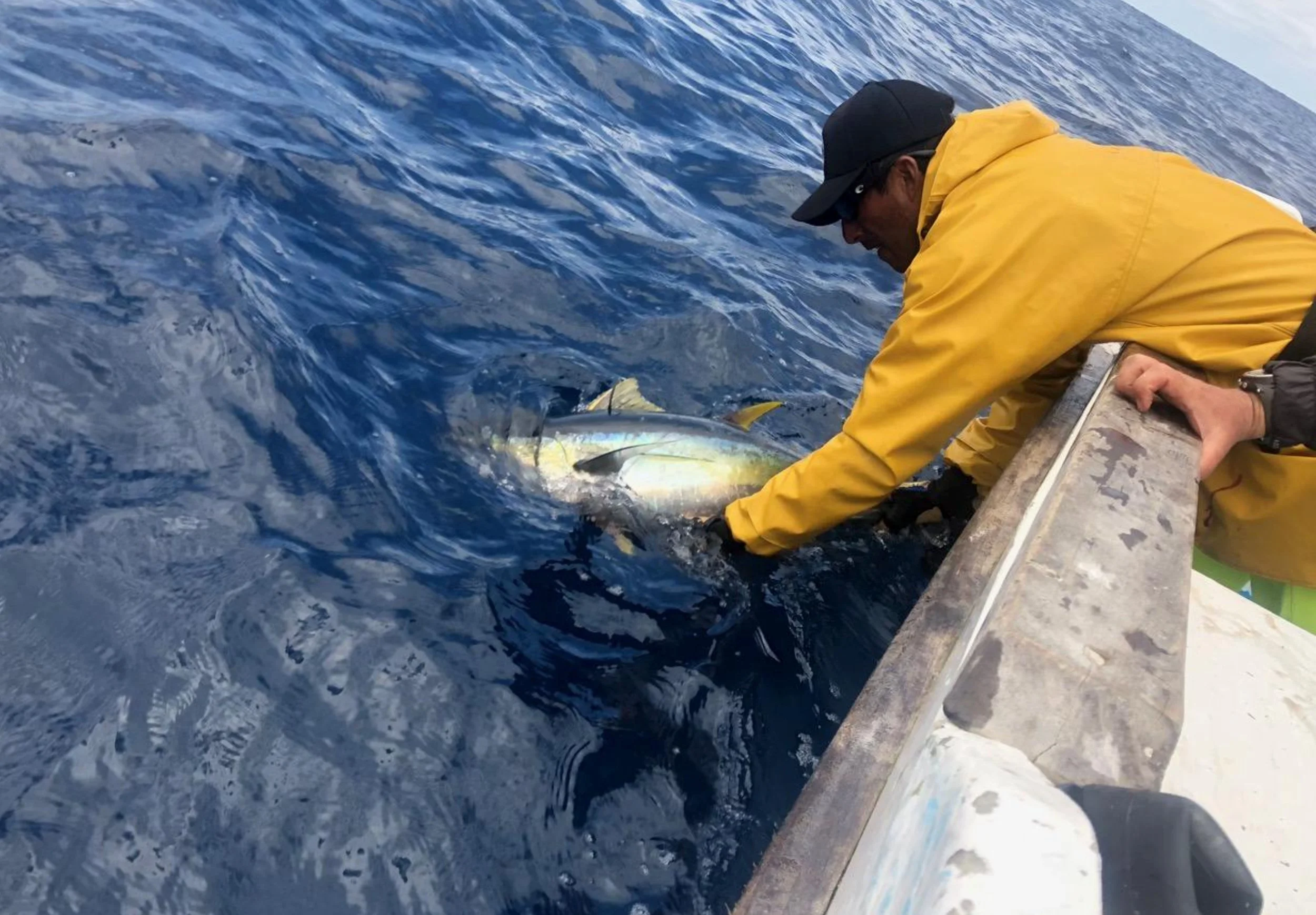NEW STUDY: Tracking Tuna in Galápagos Helps Guide Climate Change Models
Study suggests a potential narrowing habitat for tuna, with ripple effects on global fisheries and conservation.
Yellowfin Tuna, Galapagos Marine Reserve. Photo: Jonathon Green
Galápagos Marine Reserve, Ecuador - An international consortium of scientists has unveiled a groundbreaking study on the vertical movements of yellowfin tuna within the Galápagos Marine Reserve. Their findings illuminate the potential ramifications of climate change on the behavior and susceptibility of this pivotal species.
A Unified Scientific Front
The Galapagos Science Center collaborated with the School of Ocean and Earth Science at the University of Southampton, the School of Biological and Environmental Sciences at Universidad San Francisco de Quito, and the Marine Megafauna Foundation(MMF) to examine the vertical movements of yellowfin tuna. This study is part of the larger "Building Resilience in Galápagos Ecosystem Management to Severe Climate Change (R-GEMS)" project, funded by the Royal Society.
Dr. Alex Hearn, lead investigator of the larger project notes, "The R-GEMS project strives to formulate a regional oceanographic model predicting the potential impacts of climate change on marine species' behaviors over the forthcoming five decades."
Deep-sea Adventures and Oxygen Dilemmas
Researchers affixed satellite tags to eight yellowfin tuna, tracking their vertical and horizontal excursions over 4 to 97 days. Remarkably, these tuna, while primarily swimming near the surface at a median depth of 24.3 meters, intermittently delved into chillier, oxygen-depleted waters.
MMF’s Dr Chris Rohner, lead author of the study, further explains, "These occasional deep-water dives, predominantly during the day, followed by recuperative periods near the surface, suggest the tuna's need to re-oxygenate post venturing into oxygen-deprived areas."
Researchers release a Yellowfin Tuna in the Galapagos Marine Reserve. Photo: Galapagos Science Centre
An Impending Threat
Tuna are fast-swimming fishes with a high metabolic rate and thus a high demand for oxygen. Areas with low oxygen levels are normally found at great depths, but they exist around the Galápagos even at shallow depths.
This already limits the tuna’s foraging dives in this area and an expansion of these low-oxygen zones toward the surface due to climate change is predicted. This shift has the potential to reduce the areas where tuna like to swim since they seem to already prefer shallower waters. This change could possibly make them more susceptible to surface fishing methods and may limit the times they dive deep to find food.
"Our findings underscore the delicate balance marine life maintains in response to their environment," says Dr. Alberto Naveira Garabato.
A Global Perspective
Though the study orbits around the Galápagos, its revelations hold global significance. Dr. Rohner explains,
"Our research on the yellowfin tuna in the Galápagos paints a cautionary tale of the future of global marine life in a changing climate. The urgency to fortify our marine conservation efforts has never been clearer."
As the world grapples with changing ocean temperatures, recognizing its cascading impacts becomes paramount. The behavior of the Galápagos tuna provides a snapshot into how marine species may be required to adapt to their changing environments, offering a glimpse into potential future scenarios for our global ecosystem.
Read the study: Movement and vertical habitat use of yellowfin tuna Thunnus albacares in a vertically compressed habitat: the Galápagos Marine Reserve
END
About the “Building Resilience in Galápagos Ecosystem Management to Severe Climate Change (R-GEMS)” Project
This study was conducted as part of the "Building Resilience in Galápagos Ecosystem Management to Severe Climate Change (R-GEMS)" project, which is funded by the Royal Society and authorized under permit PC-18-22 by the Galápagos National Park Directorate. The primary objective of the project is to devise a fine-scale regional biogeochemical oceanographic model. This model will then be employed to discern the physical factors driving movement patterns and the spatial ecology of pivotal species in the region, both from commercial and conservation perspectives. Ultimately, this model aims to predict the potential impacts of climate change on these species' behaviors over the next five decades.
About The Galapagos Science Center
The Galapagos Science Center (GSC), located in Puerto Baquerizo Moreno in San Cristóbal-Galápagos, is a joint initiative between the San Francisco de Quito University (USFQ) and the University of North Carolina at Chapel Hill (UNC) created in 2011. The GSC is a hub to coordinate scientific research projects between local, national, and international scientists to benefit the Galápagos Islands and the world of science. The GSC aims to identify the proper balance between the natural environment and the people who live in and visit the Galápagos. This work requires scientists from different disciplines and the GSC conducts research in more than 13 research areas based on its three fundamental axes: interdisciplinary scientific research, education through science, and community outreach. www.galapagosscience.org
About The University of Southampton
The University of Southampton, located in England, is renowned for its world-leading research and educational programs. Established in 1862, it has steadily grown into one of the top 100 universities globally, with particular strengths in marine science, engineering, and the humanities. The School of Ocean and Earth Science, based at the university's waterfront campus, the National Oceanography Centre Southampton (NOCS), is at the forefront of global marine and environmental research. This esteemed school focuses on understanding the world's oceans, their biodiversity, and the impact of human activities on these fragile ecosystems. Collaborating with international partners, the University of Southampton endeavors to drive innovative research that addresses global challenges, such as climate change and its effects on marine life. For more information, visit www.southampton.ac.uk
About The Marine Megafauna Foundation
The Marine Megafauna Foundation (MMF) is a non-profit conservation organization based in Palm Beach, Florida. Founded in 2009, MMF is dedicated to the research and protection of threatened marine megafauna, focusing on large marine species like sharks, rays, and sea turtles, often referred to as 'megafauna'. Their mission is to ensure these majestic creatures thrive in harmony with humans. With a global reach, MMF works to understand these species' intricacies and the threats they face. Discover more at www.marinemegafauna.org


